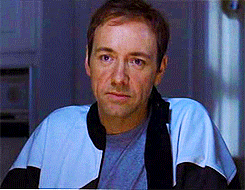My very favorite thing in all the world is a bowl of raw blackberries on a hot July day, but a very close second to blackberries (never cooked, straight off the vine) is a good Stephen Sondheim musical. And my very favorite quote about Stephen Sondheim is a quote from Frank Rich, who, writing in the NY Times of the flop that was Merrily We Roll Along, said:
I’ve held this quote close to my heart, but I never equated it to the actual act of being a fan until a month ago, when I was reading about creator Dan Harmon’s exit from NBC’s Community, scrolling past endless wailing and wearing of sackcloth on Tumblr (read: gifs of Abed and Troy having freakouts).

If you’ve never watched Community, then you’ve probably still heard from Community fans talking about how great it is. The diverse cast includes PHDs, Oscar-winners, rap stars, Betty White, and Omar from The Wire, and if that isn’t enough to sell you, it’s also an ongoing geek dream in meta-riffic serial narrative form. It’s every bit as good a show as you’ve heard it is, but what’s most important to its ultimate success or failure as a tv product is that its tailor-made for you. Yes, you, the person reading this article. You like smart, savvy stories that are steeped in meta-awareness of their own conventions but still have a deep emotional core. You access shows via all kinds of methods, and you never pay attention to ads on the rare occasion you’re accidentally suckered into watching one. At any given time, you’re probably mainlining 2 or 3 shows at once. Community knows this about you, and it loves you just as you are.
Which, of course, is the problem.
Tumblr has a large swathe of die-hard Community fans who’ve only recently gotten over the trauma of cancellation rumors, and the eleventh-hour notice that Community would return for at least a final half-season, and perhaps more. In the middle of celebrating a truly flawless 3-ep season finale that many feared would be a series finale, fans learned that Harmon, the show’s creator and show runner, who exerts a huge influence over the show and its direction, had been fired and replaced by two dudes from another statistically “quirky” show called Happy Endings. The immediate fan feeling was that the departure of Harmon, who’s spoken in the past of his incredibly hands-on relationship with the show, would kill everything that makes it special and unique. Writing bitterly on his Tumblr Saturday morning after the season finale, Harmon said, “I’m not saying you can’t make a good version of Community without me, but I am definitely saying that you can’t make my version of it unless I have the option of saying “it has to be like this or I quit” roughly 8 times a day.”
NBC and Sony view Harmon’s forced departure as a chance to “broaden” the show’s appeal to a “wider” audience.
“Wider Audience” is a Lie
These are words that will send every Community fan into a blind panic, because if you’ve ever been on the internet, you know that Community already has a huge audience. On May 17 during the finale, two show references trended worldwide on Twitter; Saturday during the outcry over Harmon’s departure, “Dan Harmon” trended for hours in the USA and even worldwide.
The internet tells me that even though Twitter has roughly half a billion users, it only takes somewhere between 1200-1500 people tweeting about a topic for it within a short period of time to become a “trend,” and that specifically the topic has to reach people who haven’t normally tweeted about it before. So the famous Community hashtag #sixseasonsandamovie can only become a worldwide trend if it starts reaching a new segment of Twitter’s active population. Presumably, all of this makes a “trend” in roughly the same way that a Nielsen rating makes up a quantifiable percentage of America’s tv-watching population: that is, if 1500 people are tweeting about watching Community, then presumably at least that many millions of people are watching Community.
The problem with this analogy is that the people tweeting about Community are not the same group of people Nielsen is tracking. There are 115 million tv owners in the US, but that doesn’t mean that all of us actually watch tv. In fact, recently released Nielsen data reveals that 17% of Americans never watch tv at all. I’ll be the first to admit that my own ambivalent relationship to my tv has created a bit of a cultural gap for me, but that gap shrinks all the time, because with the advent of the internet there’s been a huge generational shift in how people use a tv set. It’s become just another tool for many people. It’s one of many ways in which we control access to what we want to watch, and how/when we watch it:
People use television sets for watching tv, screening films, for surfing the web, recording things, listening to music, and for gaming.
People get access to television shows from Hulu, from iTunes, from Netflix, from their Roku, from the dvd-rs their friend burnt, from TIVO, from live streaming sites, from tv sets, from the box sets they bought at Best Buy, from Amazon, from torrenting and file-sharing hubs, from Youtube, from network websites, from Crunchyroll, from other sources that are probably being invented as I type this.
How many of these avenues make it into Nielsen ratings? Two–Live + Same Day: the viewing from your actual tv set, and the TIVO, or “time-shifted” view (but only if the time-shifted viewing occurs before 3am the day the show airs). According to the Nielsen website, it has an “extended screen rating” that allows it to track certain streaming sites, but this is a dubious claim with very little affect on ratings numbers. So 115 million people owning a tv set no longer means that 115 million people are going to be using it as their primary source of access to shows, but even though Nielsen hasn’t figured out how to quantify this huge cultural behavior change, Nielsen ratings are the only things networks care about.
The reason for this, of course, is advertising.
Advertising and Content Control.
Along with the huge disconnect that goes along with the assumption that means of access haven’t changed is that the means of control over content hasn’t changed. A TIVO-less or DVR-less television set gives you no control over when you view the show. While I have fond memories of college Thursday nights when my BFF & I would convene for Will & Grace come hell or high water, it’s no longer possible for everyone to carve out weekly, regularly scheduled time for sessions with their favorite TV shows. And what’s more, the number of people I want to watch tv with is also expanding. For the last several months a few of my online friends and I have been gathering in Campfire chat to watch Avatar, Korra, and Due South whenever we have free moments. It’s harried, irregular, and tv-set free. Of these three shows, only Legend of Korra is currently airing. We streamed Avatar from Netflix, and bought DVDs of Due South. Each of the networks who provide these shows has profited from our consumption of them; but none of these modes of access are part of an advertiser’s business model.
It’s not as if any of us made a conscious choice to reject exposure to ads in these shows when we got together to watch them. But we are located, respectively, in Philadelphia, Indiana, and Glasgow. We’re not going to prioritize company ad revenue over our ability to watch shows easily together–to form a community and have amazing bonding experiences around those shows. A Nielsen-compliant, advertising-friendly distribution model literally can’t give us that. We are part of the generation of people who, along with rejecting corporate-controlled content, are also rejecting advertiser-dictated content, as well as the ads themselves.
On the rare occasions I find myself watching tv–usually when I’m home visiting–I always mute commercials. This actually has caused fights with family members before, because even though turning the radio dial when commercials come on is something they don’t question, they don’t understand why I don’t want to watch the ads. The reason for me is that advertising is sexist, homophobic, gendered, ethnically profiled and stereotypical. When I watch tv, I have control over what I listen to and am exposed to, in a way that I don’t when bombarded with highway billboards, wall flyers, pamphlets on my car, and other advertisements in public spaces. And I have no problem with making the choice to filter the kinds of ads and harmful messages I’m exposed to. Why not? I make it in every other area of my life.
This fight family members and I keep having over my refusal to listen to advertisements is directly relevant to why Dan Harmon was fired. The networks and the advertisers who sponsor their shows want my mom to believe the only content she can have is the content that’s filtered through the box in her living room. But the price of accepting that content is that it comes with regular advertising that reinforces all kinds of harmful heteronormative shit about the world we live in–that girls like pink and baking and boys like action figures and building things; that women want to lose weight and find a better laundry detergent and wear makeup, and men want to objectify women, drink beer, bulk up, and live charmingly privileged lives. That queer characters don’t exist except as comic relief, and genderqueer and disabled people don’t exist at all.
It’s a bit wondrous that shows that actively question these types of stereotypes are able to sell to advertisers at all. (Mad Men is undoubtedly genius in this regard, with real-world companies lining up for ad space and major product placement on a show that’s actively critiquing everything their marketing companies are meant to do to begin with.) It’s possible that Community‘s ability to exist at all in these circumstances is a modern miracle, because as a show it sits at the crux of an entire generational and cultural gap. People who’ve killed our figurative television sets have also rejected the world advertisers try to sell us, because it doesn’t line up with reality, and because we actively operate within this culture of questioning and scrutinizing the content we intake–ads included. This description definitely applies to the audience of Community, which is a show that is 100% built around the concept that pop-culture-savviness and a pervasive rejection of outdated sociocultural values go hand in hand. As hard as NBC tries to make Community fit the mold that will allow advertisers to reach its audience in real time on Thursday Friday nights, it’s never going to happen.
To put it bluntly, you can get TV-set-controlled culture to watch bland, unironic, problematic shows like Whitney and Big Bang Theory, and you can get those shows to land significant advertising revenue, because the vast majority of people who still watch tv, much like the vast majority of people who use Facebook, are not a part of the culture of consumer-controlled content, genre savviness, remix culture, talking back, and active participation that makes up the rest of internet culture, the culture of fans who watch Community. Producer-controlled, ad-controlled-media is only as sustainable as the unreflective, unthinking, passive “couch potato” mentality people have about the act of media consumption, and that culture that is fast eroding. Community represents a paradigm shift. Community‘s success lies with an entire generation of people who don’t even register on Nielsen ratings because they don’t intake shows in ways that expose themselves to advertisers.
In order to make sure their message gets across to this “invisible” group of people, advertisers are demanding product placements directly within shows. When Community had to do this, it lampshaded the whole thing by naming a character “Subway,” turning him into a villain, and promptly disposing of him. The show that NBC wants Community to become is a more broad, bland, “mainstreamed” comedy, one that the Facebook set, the passive box-in-living-room-watching audience, can enjoy. That show is dying. That show is unsustainable. That show is dreck.
That show looks like this.
TV Shows Will Break Your Heart
I was watching the incredible outpouring of grief on Tumblr over the loss of Dan Harmon to Community, and thinking about how one of my internet friends has this tag for the media posts she makes on her journal, and it’s called “tv shows will break your heart.” For years this tag has puzzled me, because my own tv-less background has left me extremely disconnected from the culture built around following and investing in a tv series. In addition to Avatar, the only other Western television series I’ve watched until the end of their runs are Buffy and Gilmore Girls, and I discovered both series late in their runs and caught up after the fact. For a long time, it was just so utterly foreign to me, this concept that you could invest so heavily in a serial tv storyline that it could impact you this way. That tag made me want to understand what television had to offer that I’d somehow missed all my life. I’ve watched a lot of tv shows since in an attempt to plug into that feeling.
Then I watched Community. And then I spent most of April and all of May in a frenzy of dvd-buying, reading about Nielsen ratings, trying to understand why this show that’s so popular isn’t popular at all, trying to race home from work on Thursday nights to make sure my measly little tv set is turned on at 8pm, ready to mute commercials, but mostly just wanting to be counted.
And I understand, now, that it’s not the serial storytelling that breaks your heart. It’s the mode of storytelling. It’s the knowledge that a story being packaged and produced this way is only as good as the advertisers who support it and the execs who allow it to have its own voice without stifling it because of their fears that it won’t appeal to the “mainstream.”
It’s the knowledge that you aren’t who they think they’re making this show for. It’s the knowledge that your active, questioning, challenging, critique-filled, collectively-tuned-in fannishness are all qualities that the show’s producers don’t want you to have, because they’re the same qualities that drive you to want control over your own content, that drive you to reject shitty advertising, that drive you to seek alternative avenues of content consumption. “Being a fan of Community is so emotionally draining,” one frustrated fan said the night after the season finale. And I’m remembering all the outrage that still exists over shows like Beauty and the Beast, Firefly, Stargate: Atlantis–how it’s not just that the storylines were killed, but that the fanbase wasn’t the right fanbase–too female, too geeky, too old, too all of the above.
And maybe this gets at the heart of what being a fan is about, ultimately: holding your heart in your hands and investing in something that’s ultimately out of your control–with trepidation, because maybe your faith is totally misplaced, maybe the thing you’re allowing yourself to love will let you down, maybe the creator will go on a bender or fuck off for 6 years mid-series *cough* or quit halfway through the best arc, or die before it’s done; and maybe, perhaps even more likely, the people on the other side of that ugly consumer/production wall will let you down by refusing to see your value, or even refusing to acknowledge that you exist, that you matter.
________
MB, I have a confession to make: you could have had this post 5 weeks ago when I originally wrote it if I hadn’t been angstily sitting on it all this time, as if I hoped the circumstances would change and Dan Harmon would magically return to Community, and television networks would realize that the way to get people to watch tv again is to stop treating tv like it’s still a cultural source and start treating it like it’s just another tool for people to access media they want to watch.
But we live in a world where constant innovations in technology and an increasingly savvy, selective consumer culture are constantly battling corporate interests who are just trying to get the shows you love in front of your dad’s football buddies and your stay-at-home grandma–i.e., the only people who still watch tv like tv is the only thing they have to watch.
Several times during the furor over Dan Harmon’s firing, fans only-half-jokingly suggested, “Can we start a Kickstarter for Community?” Oddly enough, that’s what this conflict may boil down to: will fans of creative projects be able to directly support those projects financially in the future? Or will they continue to see the artistic and cultural merits of shows they love pitted against the priorities of advertisers who want “brand-safe content”?
The positives here may be that when push comes to shove, we can start a Kickstarter for Community–or, at the very least, for shows like it. (There actually already is a Kickstarter for a Community spinoff, the adorable Dr Who parody Inspector Spacetime.) The nature of creative consumption and production/distribution/profit from creative works is shifting so quickly that it’s difficult to say what the limits are. In fact, let’s just go ahead and assume there are no limits. As bleak as the current outlook for Community‘s future as a network television franchise may be, the outlook for consumer-generated content is brighter than ever.
And although the outlook for television and advertising companies is arguably bleaker than ever, this is the kind of cultural paradigm shift that can pave the way for a whole new kind of marketing, based on entirely new ways of reaching people where they live. And maybe the simple solution is for television networks to stop asking shows to conform to an idea of what’s “mainstream,” and instead start thinking of all streams of human contact, creativity, identity; to stop insisting that consumers of shows be advertiser-ready and start insisting that advertisers be consumer-ready: ready to deliver products for all people and speak to all people, without attempting to fit them into binaries, stereotypes, and socio-cultural pigeon-holes.
Maybe then advertisers would understand exactly how valuable a show like Community, with its ability to embrace diversity and still deliver a quality narrative product that everyone loves, can be.











 May 5th is a huge day for Hikaru no Go fans. Not only is the date extremely important in the storyline of the series itself, but the Japanese words for “5” and “Go” are identical. In fact, after he starts getting into the game of Go, the protagonist, Hikaru, is depicted wearing a t-shirt that reads, “Let’s 5!” instead of “Let’s go!”
May 5th is a huge day for Hikaru no Go fans. Not only is the date extremely important in the storyline of the series itself, but the Japanese words for “5” and “Go” are identical. In fact, after he starts getting into the game of Go, the protagonist, Hikaru, is depicted wearing a t-shirt that reads, “Let’s 5!” instead of “Let’s go!”




